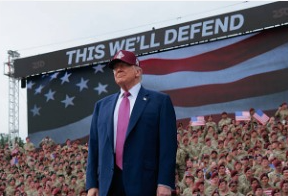Efforts to ease tensions between the US and China have culminated in a tentative agreement, announced by US President Donald Trump. The US-China trade agreement includes provisions for China to supply US companies with magnets and rare earth metals. In return, the US has agreed to rescind threats to revoke visas for Chinese students.
Crucial Highlights of the Agreement
President Trump verified the arrangement through his media platform, Truth Social, stating,” Our deal with China is done, subject to final blessing from President Xi and me.” This follows two days of ferocious accommodations in London aimed at addressing conflicts arising since a armistice was declared in May. These pressures had stemmed from a tariff escalation that oppressively disintegrated trade between the world’s two largest husbandry.
Framework and Next Steps
US Commerce Secretary Howard Lutnick described the agreement as a frame to apply the Geneva agreement. The deal remains subject to blessing by both President Trump and Chinese President Xi Jinping. Lutnick expressed sanguinity about the progress, saying,” We’re completely on the right track. effects feel really good.”
While limited details were bared, Chinese Vice Commerce Minister Li Chenggang verified that the agreement aligns with the agreement reached during a recent phone call between the two leaders and at the Geneva meeting. The accommodations also aimed to streamline the Geneva agreement, which preliminarily reduced tariffs without resolving broader trade issues.
US Tariff Strategy and Broader Trade Addresses
President Trump blazoned plans to unilaterally set tariff rates with trading mates within one to two weeks. Letters specifying the terms of new agreements will be transferred before a July 9 deadline to reimpose advanced tariffs. Treasury Secretary Scott Bessent indicated that some aggressive tariffs might remain broke to allow uninterrupted trade addresses with other nations.
Bessent also noted that trade conversations with other countries might extend beyond the administration’s 90- day deadline. He emphasized the administration’s commitment to good- faith accommodations, stating,” For those negotiating in good faith, we will roll the date forward.However, also we will not, If someone is n’t negotiating.”
Challenges and Context of the Deal
The agreement follows US enterprises over China’s detainments in exporting attractions and rare earth minerals critical for manufacturing electronics and electric vehicles. China, in turn, blamed US import controls on semiconductors and AI- related technologies and the administration’s restrictions on Chinese pupil visas.
In response, both nations have worked toward restoring trade stability. The May armistice reduced US tariffs on Chinese goods from 145 to 30, while China lowered its impositions on US significances to 10. Despite this,non-tariff pledges were traduced, egging renewed accommodations in London.
Responses and request Counteraccusations
responses to the conditional deal have been mixed. White House Press Secretary Karoline Leavitt stated that President Trump is reviewing the details and likes what he has heard so far. Lutnick characterized the addresses as productive, noting they had” gutted up” the Geneva agreement. still, trade experts like Terry Haines from Pangaea Policy expressed dubitation
about the deal’s limited compass and untreated status.
” Setting the Geneva’ pause’ back on track is the lowest of accomplishments,” Haines said, pressing that a comprehensive US- China trade agreement remains fugitive.
Literal environment of the Trade disagreement
before this time, President Trump assessed broad tariffs on significances from multiple countries, with China bearing the mass. In retribution, China introduced its own tariffs on US goods, raising pressures. The May addresses in Switzerland handed a temporary respite, reducing tariffs and establishing a 90- day window for farther accommodations. still, breaches onnon-tariff commitments reignited controversies.
Unborn Prospects for US- China Relations
The recent agreement underscores the complications of US- China trade relations. While the frame signals progress, both nations face significant challenges in achieving a comprehensive resolution. Treasury Secretary Bessent conceded that a broader agreement would bear time, stating,” It’ll be a much longer process.”
As the world watches, the outgrowth of this conditional deal could shape the future of global trade. The emphasis on resolvingnon-tariff issues and balancing geopolitical interests will probably remain central to ongoing conversations.
